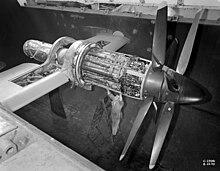Armstrong Siddeley Python

The Armstrong Siddeley Python was a turboprop - engine , which the British manufacturer Armstrong Siddeley from April 1945 produced. The machines were mainly installed in the Westland Wyvern , a heavy, carrier-based fighter . In it the machine developed about 4100 eshp (3000 kW).
construction and development
Construction actually began on a pure jet engine called the ASX , which entered the test phase in 1943. At that time, other aircraft engine projects were already in the pre-production phase and it seems that there was little need for the ASX in this form. Therefore, the design was modified by adding a reduction gear to drive a propeller . The resulting turboprop was ASP ( A rmstrong S iddeley P called ython).
Flight testing
Early tests of the flight Python were fixed by Lancaster B.1 (FE) TW911 and Lincoln B.2 RE339 / G . On both aircraft, the standard Rolls-Royce Merlin engines were replaced with Pythons. The Lincoln B.2 RF403 had also mounted two pythons in the same way and carried out altitude bombing tests in Woomera (Australia) , whereby the two pythons were used to reach higher altitudes. These experiments were essential for the ballistic casing of the Blue Danube - nuclear weapons . At that time there was no other aircraft that could take the large bomb casings with a diameter of 1575 mm and a length of 7315 mm and transport them to the desired drop height. In the first 11 tests, the highest drop altitude was 10,600 m and the highest flight speed 440 km / h with a target error of 18.6 m.
Aircraft with Armstrong Siddeley Python
- Avro Lancaster - (flight test only)
- Avro Lincoln - (flight test only)
- Westland Wyvern
Data (ASP.3)
General
- Type: Turboprop
- Length: 3129 mm
- Diameter: 1372 mm
- Weight: 1565 kg
Components
- Compressor: axial, 14-stage
- Combustion chambers: 11
- Turbine: axial, 2-stage
power
- Power: 4110 eshp at a height of 0 m including 5.25 kN thrust (3065 kW)
- Overall print ratio: 5.35: 1
- Air mass flow: 23.8 kg / s
- Specific fuel consumption: 0.365 kg / h • eshp
- Power-to-weight ratio : 0.511 kg / kW
Individual evidence
- ^ Bill Gunston: World Encyclopedia of Aero Engines . Patrick Stephens, Cambridge 1989. ISBN 1-85260-163-9 . P. 19.
- ^ The National Archives, London. File ES 1/44 E4C. Appendix 3, p. 1.
- ^ Aero Engines 1954 . In: Flight . www.flightglobal.com. April 9, 1954. Retrieved November 3, 2008.
literature
- Bill Gunston: World Encyclopedia of Aero Engines . Patrick Stephens, Cambridge 1989. ISBN 1-85260-163-9